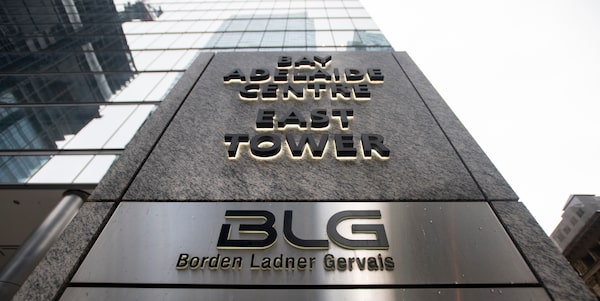
A sign for the law firm Borden Ladner Gervais outside the Bay Adelaide Centre in Toronto on Feb. 22, 2021.Fred Lum/The Globe and Mail
Seven of the largest law firms in the country have signalled they are willing to share gender wage-gap data for research purposes, similar to what firms in the United States and Britain have been doing for years.
Borden Ladner Gervais, Norton Rose Fulbright, Stikeman Elliott, Aird & Berlis, Dentons, Stewart McKelvey and MLT Aikins – representing more than 3,100 lawyers – all left the door open to the possibility, in response to recent questions from The Globe and Mail.
Several of the firms stated that, as private companies, they would be uncomfortable revealing their full compensation grids or specific salaries – for competitive and privacy reasons – but were open to reporting the difference between what men and women earn. Firms also noted there would need to be discussions around methodology, as well as how the information would be collected and communicated. But in general, each of the firms were supportive of more specific wage-gap transparency.
How we did it: A look at how The Globe collected and analyzed salary data for the Power Gap
“We want to help identify the problem and be part of the solution,” said Lydia Bugden, chief executive officer and managing partner of Stewart McKelvey, noting one way to do this would be for firms to share their gender wage-gap percentages.
Aaron Runge, managing partner of MLT Aikins, said in a statement: “We see great value in having representative, cross-country data that can help the legal industry establish benchmarks and track progress, and we would benefit from participation and access to the final aggregate data.”
This is a significant shift.
Three years ago, the Canadian Bar Association’s Women Lawyers Forum attempted to conduct a partner compensation survey – mirroring the one produced by the National Association of Women Lawyers (NAWL) in the U.S. But firms refused to provide numbers, even expressed as a percentage, and even though the results would be anonymous.
As a result, the extent of the gender wage gap in the Canadian legal profession has largely remained a mystery. A 2020 survey of in-house counsel showed that, on average, women lawyers working in corporate legal departments made 11 per cent less than their male counterparts. But private firms, where the majority of lawyers work, have never participated in a similar survey.
In fact, the majority of the two dozen firms questioned by The Globe are still refusing to take this step.

A small plaque for the law firm Dentons, placed in an elevator at TD Centre on Feb. 22, 2021.Fred Lum/The Globe and Mail
Four firms declined to answer The Globe’s questions: Fasken, DLA Piper, Davies, and Cox & Palmer. McInnes Cooper said it would not comment on staff compensation models and Goodmans and Osler said they do not share compensation data outside of the partnership.
McCarthy Tétrault, Bennett Jones, Torys, Lavery, Cain Lamarre and BCF did not acknowledge multiple e-mails.
Blakes did not address the question of whether it would consider sharing wage-gap data, and instead included details of other diversity and inclusion initiatives.
Gowling WLG, Miller Thomson and McMillan acknowledged The Globe’s e-mail, but did not provide answers in time for publication.
Earlier this month, The Globe revealed that female equity partners at Cassels Brock & Blackwell made an average of about 25 per cent less than the men, according to a confidential document that showed projected compensation for 2019. This worked out to male equity partners earning about $200,000 more a year. Additionally, about 75 per cent of Cassels’ 116 equity partners that year were men. Of the women, it appears just four were women of colour, and three were among the lowest-earning quartile.
This trend continued at the associate level, where the men out-earned the women, particularly when it came to bonuses. “Over 80 per cent of men got a bonus, only 44 per cent of women did,” read an internal e-mail reviewed by The Globe.
Cassels said that while it could not “comment extensively on highly private and confidential documents,” the firm has promoted 19 women to equity partner in the past four years.
“As you would expect, early-stage partners – both men and women – require time to rise up our compensation grid,” Cassels’ deputy managing partner Kristin Taylor said in a statement. “It also is worth noting that, for the past two years, women have risen more quickly up our compensation grid than their male counterparts.”
Because of the lack of data, it’s unclear whether Cassels’ numbers are representative of other firms, but information from other jurisdictions suggests it is.
In the United Kingdom, businesses with 250 employees or more must publicly report wage-gap data, law firms included – many of which also voluntarily disclose partner figures. At DLA Piper U.K., for example – whose Canadian branch declined to answer questions from The Globe – the gender gap at the partner level was 24.7 per cent. Even some smaller firms are pro-actively releasing their statistics, said Christina Blacklaws, former president of the Law Society of England and Wales.
“In addition, some firms have voluntarily started to include ethnicity pay gap, disability and LGBTQ+. There’s a movement and desire to report beyond the government requirement,” Ms. Blacklaws said.
At Norton Rose’s U.K. office, the firm reported an overall average ethnicity pay gap of 14.4 per cent. The report shows its LGBTQ+ staff made 9.5 per cent more. (It should be noted that one-third of employees did not disclose race, and 40 per cent didn’t disclose sexual orientation.)

A sign for the law firm Aird Berlis outside Brookfield Place on Feb. 22, 2021.Fred Lum/The Globe and Mail
In the U.S., where NAWL has been surveying the country’s 200 largest firms for 13 years, female partners have been shown to make about 15 per cent less. (About half of the firms respond to the survey; of those, between 35 and 40 per cent provide compensation figures.)
Destiny Peery, who has been the principal investigator of the NAWL survey for the past five years, said the numbers show a small but persistent compensation gap of about 7 per cent at the associate and non-equity or income partner level (the first stage of partnership).
Historically, Ms. Peery said, the push for diversity, equity and inclusion has focused on women. “By virtue of being half the population and half of law-school graduates, it seemed quite obvious.”
But in recent years, this work has expanded to include other measures of diversity.
“There is a push to go beyond what seemed like the easier element of diversity … the idea that, when you talk about who is getting access to equity partner, women as a whole do have much less access than men,” she said. “But … it’s mostly white women to make it to that level.”
The latest NAWL survey, which also collects demographic information, showed 21 per cent of equity partners in the U.S. are women. Of those, just 14 per cent are women of colour.
The Globe reached out to the two dozen largest firms in Canada (as identified by the legal resource Lexpert) to ask whether they would consider sharing wage-gap data.
Aird & Berlis was one of the seven firms that said they were open to it. “Pay equity is important to us and the broader legal profession,” managing partner Steven Zakem said. “We would consider participating in any initiative that seeks to understand and address the gender compensation gap between male and female lawyers.”
BLG’s statement read: “Although we view compensation as confidential, we would be prepared to participate in a broader dialogue regarding compensation and diversity,” including potentially providing wage-gap data to a professional research body.
Dentons said it would be “supportive of a sector-wide initiative and believe it would assist all firms in determining where gaps exist and, ultimately, what needs to change in order to close those gaps.”
Stikeman Elliott indicated it would need to consider a number of factors, including “the methodology, the questions, how the data will be preserved, aggregated and presented to ensure individual privacy … and to whom the results will be made available and for what use.” But, “if overseen and developed as described above, we would seriously consider participating in such a survey.”
Norton Rose said that “should a reputable legal association lead an initiative to gather data on our sector, we would be happy to contribute by sharing some of our own information and analysis, as well as learnings, on the wage gap. We would need to discuss what that might include, but don’t envision providing detailed information like compensation grids for competitive and commercial reasons.”
As for the Canadian Bar Association, president Brad Regehr said more transparency is necessary – not just around compensation, but also who’s going to law school, who’s graduating, where they end up and the success of equality-seeking groups.
“What gets measured gets done. Having better data and transparency can help accelerate change.”
Our Morning Update and Evening Update newsletters are written by Globe editors, giving you a concise summary of the day’s most important headlines. Sign up today.